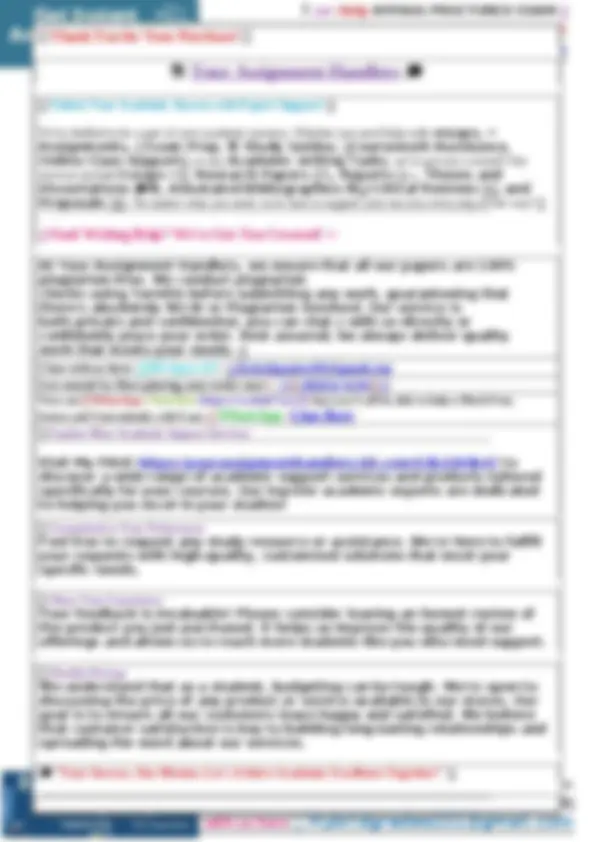Download ATLS Chapter 3 Shock Review ATLS Exam Questions and Answers | 100% Pass Guaranteed | Grade and more Exams Traumatology in PDF only on Docsity!
ACS American College of
Surgeons
ATLS Advanced Trauma Life Support
ATLS Written Examination & Practical Skills
Assessment
ATLS Final Exams
Course Title and Number: ATLS Written Examination &
Practical Skills Assessment
Exam Title: ATLS Exam
Exam Date: Exam 2025- 2026
Instructor: ____ [Insert Instructor’s Name] _______
Student Name: ___ [Insert Student’s Name] _____
Student ID: ____ [Insert Student ID] _____________
Examination
Time: - ____ Hours: ___ Minutes
Instructions:
- Read each question carefully.
- Answer all questions.
- Use the provided answer sheet to mark your responses.
- Ensure all answers are final before submitting the exam.
- Please answer each question below and click Submit when you have completed the Exam.
- This test has a time limit, The test will save and submit automatically when the time expires
- This is Exam which will assess your knowledge on the course Learning Resources.
Good Luck……...!
📱Hit Me UP__ Inbox Open 24/7 – 365 …...!!!!
📱 Chat with us here : 📱 Hybridgrades101@gmail.com
ATLS Chapter 3 Shock Review ATLS Exam Questions and Answers | 100% Pass Guaranteed | Graded A+ | 2025- ATLS Modules / Chapter Review
ATLS Written Examination & Practical Skills
Assessment
ATLS Advanced Trauma Life Support Exam Read All Instructions Carefully and Answer All the Questions Correctly Good Luck: -
identify shock: - =Answer>> Inadequate tissure perfusion and oxygenation
definition of shock - =Answer>> abnormality of circulatory system results in
inadequate organ perfusion and tissue oxygentain
after shock is seen clinically then what - =Answer>> identify what is causing
shock
Types of shock - =Answer>> 1) Hypovolemic/hemorrhagic
- Septic
- Cardiogenic
- Obstructive
- Neurogenic
First of the managing shock and trauma is - =Answer>> recognizing shock.
2nd step in managing shock is - =Answer>> identifying the probable cause of
shock and adjust treatment accordingly.
Most common cause of shock in trauma patient is? - =Answer>> Hemorrhage.
Need Writing 📱Help? We've Got You Covered! ✍ 100% NO A I or Plagiarism Guaranteed📱
Click Here To <> Follow Link
https://yourassignmenthandlers.kit.com/93b2309b
!!!.ORDER NOW.!!! << TO GET INSTANT EXPERT HELP >> !!!.ORDER
NOW.!!!
📱Hit Me UP__ Inbox Open 24/7 – 365 …...!!!!
📱 Chat with us here : 📱 Hybridgrades101@gmail.com
-Respiratory distress, subcutaneous emphysema, unilateral breath sounds, hyperresonance to percussion, tracheal shift
Tension pneumothorax treatments - =Answer>> needle or finger
decompression Neurogenic shock- -isolated intracranial injuries do not cause shock, unless brainstem is injured -
=Answer>> - Classic presentation is hypotension without tachycardia or
cutaneous vasoconstriction -(Narrow pulse pressure is not seen) Hemorrhagic shock-hemorrhage is the most common cause of shock and trauma
patients. - =Answer>> Response to blood loss is fluid SHIFTS
Subsequent volume replacement as determined by the patient's response to therapy -
=Answer>> class 1 hemorrhage= condition of an individual who has donated 1
unit of blood class 2 uncomplicated hemorrhage for which crystalloid fluid resuscitation is required 3= complicated hemorrhoids requiring at least crystalloid infusion and perhaps also blood replacement 4= preterminal events, unless aggressive measures are taken, patient will die within minutes. Blood transfusion is required
Less than 15% blood volume loss is class? - =Answer>> class I hemorrhage
-Minimal tachycardia -Otherwise healthy patient
Class II hemorrhage - =Answer>> -15 to 30% approximate blood loss
- Possible need for blood products -Clinical signs include tachycardia, tachypnea, decreased pulse pressure
Class III hemorrhage - =Answer>> -31 to 40% approximate blood loss
-Need for blood products-yes -Marked tachycardia and tachypnea, significant mental status changes, measurable fall and systolic blood pressure.
Class 4 hemorrhage - =Answer>> -Greater than 40% blood loss
-Massive transfusion protocol -Marked tachycardia, significant decrease in systolic BP, very narrow pulse pressure or unmeasurable diastolic pressure Need Writing 📱Help? We've Got You Covered! ✍ 100% NO A I or Plagiarism Guaranteed📱
📱Hit Me UP__ Inbox Open 24/7 – 365 …...!!!!
📱 Chat with us here : 📱 Hybridgrades101@gmail.com
It is dangerous to wait until trauma patient fits physiologic classification of shock before
initiating volume restoration. - =Answer>> -Initiate hemorrhage control and
balance fluid resuscitation when early signs and symptoms of blood loss are apparent or suspected, not 1 pressure is falling or absent. Stop bleeding.
Basic principles of management of hemorrhagic shock is to - =Answer>> stop
bleeding and replace volume loss
PHYSICAL EXAM in trauma ABCDEs - =Answer>> -C=Circulation: Priority is
to stop bleeding, not calculated volume or fluid loss -E=exposure: When exposing a patient, it is a essential to prevent hypothermia, a condition that can exacerbate blood loss by contributing to coagulopathy and worsening acidosis.
In unconscious, gastric distention increases the risk of - =Answer>> aspiration
of gastric contents, a potentially fatal complication.
Initial fluid therapy? - =Answer>> Administer warm fluid bolus of isotonic fluid,
usual dose is 1 L for adult and 20 mL/kg pediatric patients weighing less than 40 kg. Persistent infusion of large volumes of fluid and blood in an attempt to achieve normal
blood pressure is not a substitute for - =Answer>> definitive control of
bleeding.
Responsive to initial fluid resuscitation - =Answer>> RAPID vs transiet vs
Minimal/no, Initial response to fluid resuscitation is key to determining subsequent therapy
Rapid response=good response - =Answer>> -Vitals returned to normal,
minimal estimated blood loss, type and crossmatch blood preparation
Transient response - =Answer>> -Increased heart rates, decreased blood
pressure only some improvement, moderate versus ongoing blood loss, type specific blood preparation
Minimal or no response - =Answer>> -Patient remains abnormal, emergency
blood release Need Writing 📱Help? We've Got You Covered! ✍ 100% NO A I or Plagiarism Guaranteed📱
📱Hit Me UP__ Inbox Open 24/7 – 365 …...!!!!
📱 Chat with us here : 📱 Hybridgrades101@gmail.com
Why is lactic acid elevated in shock? - =Answer>> At the cellular level,
inadequately perfused and poorly oxygenated cells switch to anaerobic metabolism resulting in lactic acid formation and development of lactic acidosis
Why are vasopressors contraindicated in shock? - =Answer>> they worsen
tissue perfusion Compensatory mechanisms in shock can prevent a measurable fall in systolic pressure
until what percent of blood volume is lost? - =Answer>> 30%
Causes of cardiogenic shock - =Answer>> Blunt cardiac injury
Cardiac tamponade Air embolus Myocardial infarction
Signs of neurogenic shock - =Answer>> hypotension without tachycardia or
cutaneous vasoconstriction no narrowed pulse pressure
Evaluate these 4 things to identify shock - =Answer>> 1. respiratory rate
- pulse rate and character
- skin perfusion
- pulse pressure
Blood volume is what percent of body weight? - =Answer>> 7% for adults
8-9% for a child
Class I hemorrhage amount of blood loss - =Answer>> <15%
Class II hemorrhage amount of blood loss - =Answer>> 15%-30%
Class III Hemorrhage amount of blood loss - =Answer>> 31-40%
Class IV hemorrhage blood loss - =Answer>> >40%
Amount of blood loss possible in tibia or humerus fracture - =Answer>> 750
mL
Amount of blood loss possible in femur fracture - =Answer>> 1500 mL
Need Writing 📱Help? We've Got You Covered! ✍ 100% NO A I or Plagiarism Guaranteed📱
📱Hit Me UP__ Inbox Open 24/7 – 365 …...!!!!
📱 Chat with us here : 📱 Hybridgrades101@gmail.com
4 types of shock causing hypovolemia - =Answer>> 1. Obstructive 2.
cardiogenic, 3. neurogenic
- septic (rare)
Obstructive shock example - =Answer>> Tension pneumo. cardiac
tamponade,
Neurogenic shock is - =Answer>> extensive injury to cervical or upper thoracic
spinal cord
do isloated brain injuries cause shock - =Answer>> NO
what is the most common cause of a trauma shock patient - =Answer>>
Hemorrhage
easiest and earliest measure of shock - =Answer>> tachycardia
Shock causes the release of endogenous catacholines which - =Answer>>
increase peripheral vascularresistance, which increases diastolic blood pressure and reduces pulse pressure but does not increse organ perfusion
hormones with vosoactive properities released during shock are: - =Answer>>
histamine, bradykinin, B-endorphins, prostanoids & cytokines bleeding compensation occurs with shifting to anaerobic metabolism this causes
formation of what - =Answer>> lactic acid= metabolic acidosis
initial treatment of shock involves - =Answer>> restoring cellular and organ
perfusion with oxygentaed blood
why are vasopressors contraindicated - =Answer>> they worsen tissue
perfusion any injured ADULT who is cool and tachycardia is consider to be in what -
=Answer>> shock until prove otherwise
tachycardia - =Answer>> Adult over 100
child 120 preschool age child- infants- Need Writing 📱Help? We've Got You Covered! ✍ 100% NO A I or Plagiarism Guaranteed📱
📱Hit Me UP__ Inbox Open 24/7 – 365 …...!!!!
📱 Chat with us here : 📱 Hybridgrades101@gmail.com
how does a tension pneumo develop - =Answer>> when air enters the pleural
space, but flap valve mechanism prevents the air from escaping
Tension pneumo air in pleural space rises causing - =Answer>> total lung
collapse and a sheft of the mediastinum to the opposite side with impirment of venous return and fall in CO
Tension pneumo causes - =Answer>> acute respiratory distress, sub Q
emphysema, absent breath sounds, hyperresonance to percussion and tracheal shift
diagnosis of tension pneumo now what - =Answer>> needle decompression
until able to put in a chest tube
Do isolated intracranial injuries cause shock - =Answer>> NOOOOO
Cervical or upper thoracic spinal cord injury can cause - =Answer>>
hypotension due to loss of sympathetic tone
classic picture of neurogenci shock is - =Answer>> hypotension without
tachycardia or cutaneous vasoconstriction
A narrowed pulse pressure is not seen in what - =Answer>> Neurogenic shock
fluid resuciation without results should think of - =Answer>> continued
hemmorrhage or neurogenic shock
shock due to infection immediatley after injury is uncommon is - =Answer>>
septic shock delay of treatment for several hours of a penetrating dirty would can cause -
=Answer>> septic shock
early septic shock symptoms are - =Answer>> modest tachy, warm skin,
systolic pressure near normal, wide pulse pressure
hemorrhage is defined as - =Answer>> active loss of circulating blood volume
normal adult blood volume is what percentage of body weight - =Answer>> 7%
obese adults blood volume is determined looking at their - =Answer>> ideal
weight not the weight they are Need Writing 📱Help? We've Got You Covered! ✍ 100% NO A I or Plagiarism Guaranteed📱
📱Hit Me UP__ Inbox Open 24/7 – 365 …...!!!!
📱 Chat with us here : 📱 Hybridgrades101@gmail.com
normal child blood volume is - =Answer>> 8-9% of body weight
Class I hemorrhage -up to 15% - =Answer>> example is blood donation
Class II hemorrhage -15-30% - =Answer>> uncomplicated resolved with IV
fluids
Class III hemorrhage - =Answer>> complicated Iv fluids and blood products
always require transfusions
Class IV hemorrhage - =Answer>> death without immediate measures
Risk factors for hemorrhagic shock are - =Answer>> Age, severity of injury,
time of injury and treatment, prehospital fluid, medications for chronic conditions
increase in circulating catacholamines causes - =Answer>> tachycardia,
tachypnea, decreased pulse pressure
Pulse pressure instead of systolic early due to what - =Answer>> systolic
blood pressure may not lower in early shock so check pulse pressure
what CNS signs are seen with hemorrhagic shock - =Answer>> anxiety and
agitation
Urine output in an adult is typically what - =Answer>> 20-30ml per hour
Class III signs are - =Answer>> tachycardia, tachypnea, changes in mental
status, and fall in systolic pressure
reasons to transfuse - =Answer>> extreme loss, but also no respond to IV
fluids
Iv size in trauma - =Answer>> 2 large bore sites 16 gauge
most desireable sites for peripheral percutaneous IV lines in adults are -
=Answer>> forearms and anticubital veins
if unable to use peripheral veins then what - =Answer>> saphenous vein
cutdown Need Writing 📱Help? We've Got You Covered! ✍ 100% NO A I or Plagiarism Guaranteed📱
📱Hit Me UP__ Inbox Open 24/7 – 365 …...!!!!
📱 Chat with us here : 📱 Hybridgrades101@gmail.com
minimal or no response what else should be considered besides hemorrhage -
=Answer>> pump failure resulting from cardiac tamponade, tension
pneumothoras, or blunt cardiac injury
what patients will need blood products - =Answer>> Class III or Class IV, and
transient or non responders
what is the main purpose for blood transion - =Answer>> restore the oxygen
carrying capacity
wht type of blood is perfered in blood transfusions - =Answer>> Fully
crossmatched blood
If unable to crossmatch what type blood would you use - =Answer>> Type O
What type blood is perferred for females of childbearing age - =Answer>> Rh-
negative
Can blood products be heated in microwave - =Answer>> No
Can IV fluids be heated in microwave - =Answer>> yes
Do patients getting blood transfusions need ionized calcium - =Answer>> NO
An increase in blood ressure should not be what - =Answer>> equated with a
concomitant increse in cardiac output or the recovery of shock
Elderly patient have a ____in catacolamine response - =Answer>> decrease
Pregnancy, hypervolemia requires a _____loss to manifest perfusion -
=Answer>> increases
Need Writing 📱Help? We've Got You Covered! ✍ 100% NO A I or Plagiarism Guaranteed📱
📱Hit Me UP__ Inbox Open 24/7 – 365 …...!!!!
📱 Chat with us here : 📱 Hybridgrades101@gmail.com
Need Writing 📱Help? We've Got You Covered! ✍ 100% NO A I or Plagiarism Guaranteed📱
📱Hit Me UP__ Inbox Open 24/7 – 365 …...!!!!
📱 Chat with us here : 📱 Hybridgrades101@gmail.com
https://yourassignmenthandlers.kit.com/93b2309b Need Writing 📱Help? We've Got You Covered! ✍ 100% NO A I or Plagiarism Guaranteed📱


























